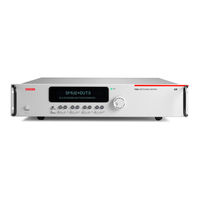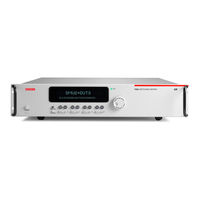Tektronix KEITHLEY 708B Manuals
Manuals and User Guides for Tektronix KEITHLEY 708B. We have 4 Tektronix KEITHLEY 708B manuals available for free PDF download: Reference Manual, User Manual, Quick Start Manual
Tektronix KEITHLEY 708B Reference Manual (555 pages)
Switching System
Brand: Tektronix
|
Category: Network Accessory
|
Size: 8 MB
Table of Contents
-
Overview18
-
Introduction18
-
Pseudocards40
-
Scan List45
-
Events60
-
Overview61
-
Mainframe62
-
Backplane65
-
Front Panel66
-
+5 V Output71
-
GPIB Setup95
-
Enable GPIB98
-
Terminator100
-
Visa108
-
NI-VISA Runtime110
-
Card Pages114
-
Stop the Scan123
-
TSB Embedded125
-
Admin Page130
-
Unit Page131
-
LXI Page132
-
In this Section137
-
Queries140
-
Beeper Control141
-
Data Queue143
-
Delay Function143
-
Digital I/O143
-
Display144
-
Error Queue144
-
Exit Function145
-
Gpib145
-
LAN and LXI146
-
Local Node147
-
Memory Functions147
-
Print Functions148
-
Reset148
-
Scan148
-
Scripting149
-
Slot149
-
Timer Functions150
-
TSP-Link151
-
TSP-Net152
-
In this Section153
-
What Is a Script154
-
Manage Scripts155
-
Run Scripts158
-
What Is Lua166
-
Lua Basics166
-
Variable Types168
-
Hello World172
-
Loop Control176
-
While Loops176
-
For Loops177
-
Script Editor187
-
Rename a Script192
-
TSP-Link Nodes199
-
Initialization201
-
Assign Groups205
-
TSP-Net208
-
Example Script210
-
Vxipnp Drivers214
-
Labview Drivers215
-
In this Section216
-
Placeholder Text216
-
Syntax Rules217
-
Command Usage220
-
Command Details221
-
Example Section221
-
TSP Commands222
-
Beeper.beep()222
-
Beeper.enable223
-
Bit.bitand()223
-
Bit.bitor()224
-
Bit.bitxor()225
-
Bit.clear()225
-
Bit.get()226
-
Bit.getfield()227
-
Bit.set()228
-
Bit.setfield()229
-
Bit.test()230
-
Bit.toggle()231
-
Channel.close()233
-
Channel.open()250
-
Channel.reset()257
-
Dataqueue.add()265
-
Dataqueue.count268
-
Dataqueue.next()269
-
Delay()270
-
Digio.readbit()270
-
Digio.readport()271
-
Digio.writebit()280
-
Display.clear()282
-
Display.menu()293
-
Display.prompt()294
-
Display.screen296
-
Errorqueue.count302
-
Eventlog.all()304
-
Eventlog.clear()305
-
Eventlog.count305
-
Eventlog.enable306
-
Eventlog.next()307
-
Exit()309
-
Format.byteorder310
-
Format.data311
-
Gettimezone()312
-
Gpib.address313
-
Lan.lxidomain321
-
Lan.nagle322
-
Lan.reset()322
-
Lan.status.speed329
-
Localnode.define340
-
Localnode.model343
-
Makegetter()349
-
Makesetter()349
-
Memory.used()351
-
Opc()354
-
Print()355
-
Printnumber()356
-
Reset()357
-
Scan.abort()358
-
Scan.add()359
-
Scan.bypass362
-
Scan.create()363
-
Scan.execute()364
-
Scan.list()364
-
Scan.mode366
-
Scan.reset()367
-
Scan.scancount368
-
Scan.state()369
-
Scan.stepcount370
-
Script.anonymous375
-
Script.delete()376
-
Script.new()376
-
Script.restore()378
-
Script.run()379
-
Scriptvar.list()381
-
Scriptvar.name382
-
Scriptvar.run()383
-
Scriptvar.save()383
-
Scriptvar.source384
-
Settime()384
-
Settimezone()385
-
Slot[Slot].Idn386
-
Status.condition390
-
Status.operation396
-
Status.reset()407
-
Status.standard407
-
Status.system410
-
Status.system2412
-
Status.system3414
-
Status.system4416
-
Status.system5418
-
Timer.reset()422
-
Trigger.clear()428
-
Trigger.event_Id428
-
Trigger.wait()437
-
Tsplink.group438
-
Tsplink.master438
-
Tsplink.node439
-
Tsplink.reset()441
-
Tsplink.state442
Advertisement
Tektronix KEITHLEY 708B Reference Manual (534 pages)
Brand: Tektronix
|
Category: Matrix Switcher
|
Size: 9 MB
Table of Contents
-
Introduction16
-
Overview16
-
Wiring19
-
Power-Up27
-
Display29
-
Menu Options36
-
GPIB Setup47
-
Introduction83
-
Card Pages85
-
TSB Embedded92
-
Admin Page94
-
Unit Page94
-
LXI Page95
-
Reset a Channel114
-
Pseudocards115
-
Trigger Model118
-
Events138
-
Event Blenders138
-
Mainframe140
-
Front Panel144
-
Queries150
-
Beeper Control150
-
Data Queue154
-
Delay Function154
-
Digital I/O155
-
Display155
-
Error Queue155
-
Exit Function156
-
Gpib156
-
LAN and LXI157
-
Local Node158
-
Memory Functions158
-
Opc Function158
-
Print Functions158
-
Reset158
-
Scan159
-
Scripting159
-
Slot160
-
Timer Functions160
-
TSP-Link161
-
TSP-Net162
-
Userstrings162
-
Vxipnp Drivers164
-
Labview Drivers165
-
Introduction185
-
What Is Lua186
-
Lua Basics186
-
Script Editor208
-
Rename a Script212
-
TSP-Link System219
-
TSP-Link Nodes219
-
Initialization221
-
TSP-Net227
-
Overview227
-
Placeholder Text232
-
Syntax Rules233
-
Command Usage236
-
Command Details237
-
Example Section237
-
Beeper.beep()239
-
Beeper.enable239
-
Bit.bitand()240
-
Bit.bitor()240
-
Bit.bitxor()241
-
Bit.clear()242
-
Bit.get()242
-
Bit.getfield()243
-
Bit.set()244
-
Bit.setfield()245
-
Bit.test()245
-
Bit.toggle()246
-
Channel.close()248
-
Channel.open()264
-
Channel.reset()271
-
Dataqueue.add()279
-
Dataqueue.count281
-
Dataqueue.next()281
-
Delay()283
-
Digio.readbit()283
-
Digio.readport()284
-
Digio.writebit()292
-
Display.clear()294
-
Display.menu()304
-
Display.prompt()305
-
Display.screen306
-
Errorqueue.count314
-
Eventlog.all()315
-
Eventlog.clear()316
-
Eventlog.count317
-
Eventlog.enable317
-
Eventlog.next()318
-
Exit()319
-
Format.byteorder320
-
Format.data321
-
Gettimezone()323
-
Gpib.address323
-
Lan.lxidomain331
-
Lan.nagle331
-
Lan.reset()332
-
Lan.status.speed338
-
Localnode.define349
-
Localnode.model352
-
Makegetter()358
-
Makesetter()359
-
Memory.used()361
-
Opc()362
-
Print()362
-
Printbuffer()365
-
Printnumber()365
-
Reset()366
-
Scan.abort()366
-
Scan.add()367
-
Scan.bypass371
-
Scan.create()372
-
Scan.list()374
-
Scan.mode376
-
Scan.reset()377
-
Scan.scancount378
-
Scan.state()379
-
Scan.stepcount380
-
Script.anonymous386
-
Script.delete()387
-
Script.new()387
-
Script.restore()390
-
Script.run()390
-
Scriptvar.list()393
-
Scriptvar.name393
-
Scriptvar.run()394
-
Scriptvar.save()395
-
Scriptvar.source396
-
Settime()396
-
Settimezone()397
-
Slot[X].Idn399
-
Status.operation408
Tektronix KEITHLEY 708B User Manual (66 pages)
Switching System
Table of Contents
-
Installation10
-
Introduction10
-
Dimensions10
-
Weights14
-
+5 V Output18
-
Display24
-
Power Switch29
-
Menu Options33
-
Introduction43
-
Display44
-
Maintenance54
Advertisement



